SEVEN-STAR ANCHOR AND SLANTINGLY THROW STEP
How are these two Chen Style Taijiquan patterns, "Seven-Star Anchor" and "Slantingly Throw Step", used in combat?

|
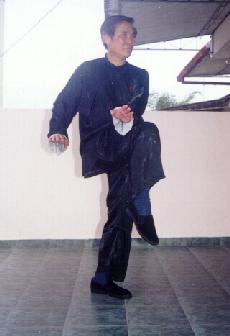
|
The two kungfu patterns shown above, "Seven-Star Anchor" and "Slantingly Throw Chest", are from Chen Style Taijiquan, the one among the many Taijiquan styles that is best known for combat function. The pattern "Seven-Star Anchor" is also known by another name as "Leaning at the Back", and "Slantingly Throw Step" also known as "Throw Step in front of Chest".
Martial art students who are used to sparring as a generous exchange of kicks and blows, will wonder how on earth these two flowery-looking patterns can be used for fighting. Why does the exponent place one hand at his waist? Why does he raise one leg? The following two sequences illustrate their combat application.
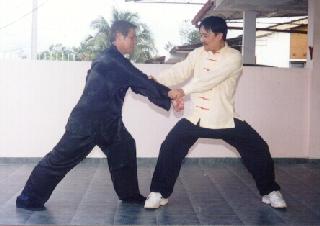
|
Goh Kok Hin grips my right arm with his two hands, using a Shaolin kungfu pattern called "Old Eagle Catches Snake".
Following his pulling momentum I move my back right leg forward and place it near his front leg. Simultaneously I circulate my right arm in a big anti-clockwise direction. This circulating movement not only releases Goh's grip on my arm but also results in my gripping his right wrist with my right hand.
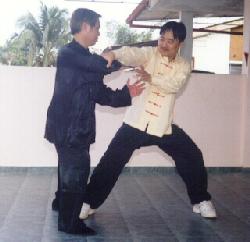
|

|
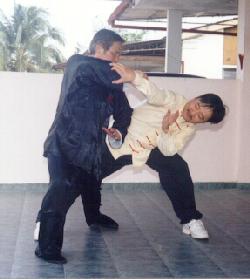
|
Immediately I move my left leg deep in between Goh's two legs, pull his right arm towards me to my right side, and strike my bent elbow into his left ribs. I place my left hand against my left waist to form a "seven-inch anchor" as the opponent falls onto my bent elbow.
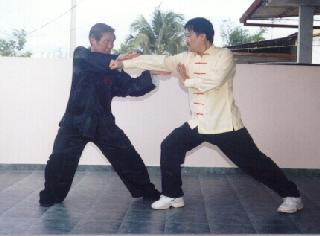
|
The combat function of the pattern "Slantingly Throw Step" is actually quite obvious and simple, although Taiji dancers as well as free-style fighters may not realize it.

|
The combat application of another Chen Style Taijiquan pattern Immortal Pounds Mortar is explained in another webpage.
